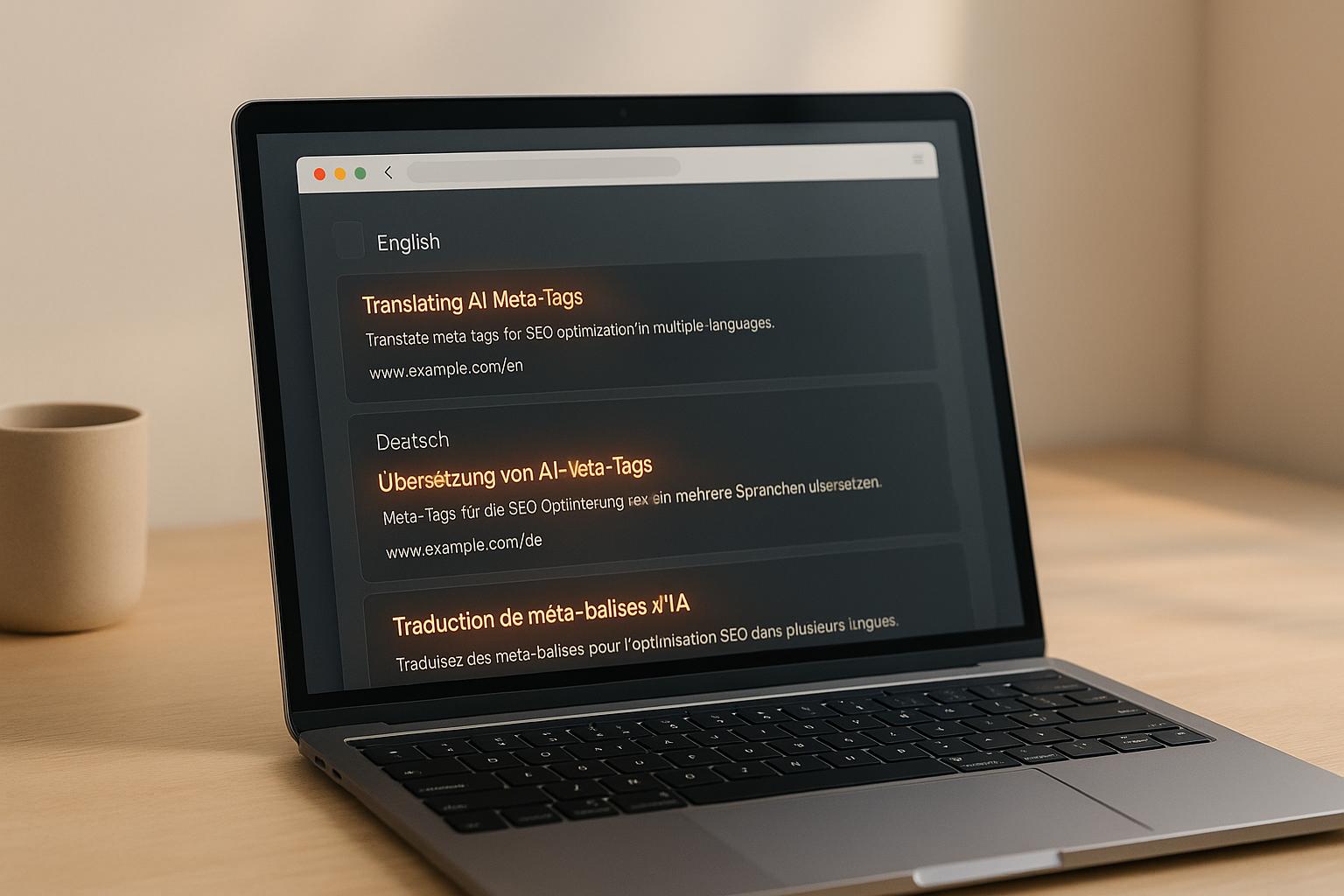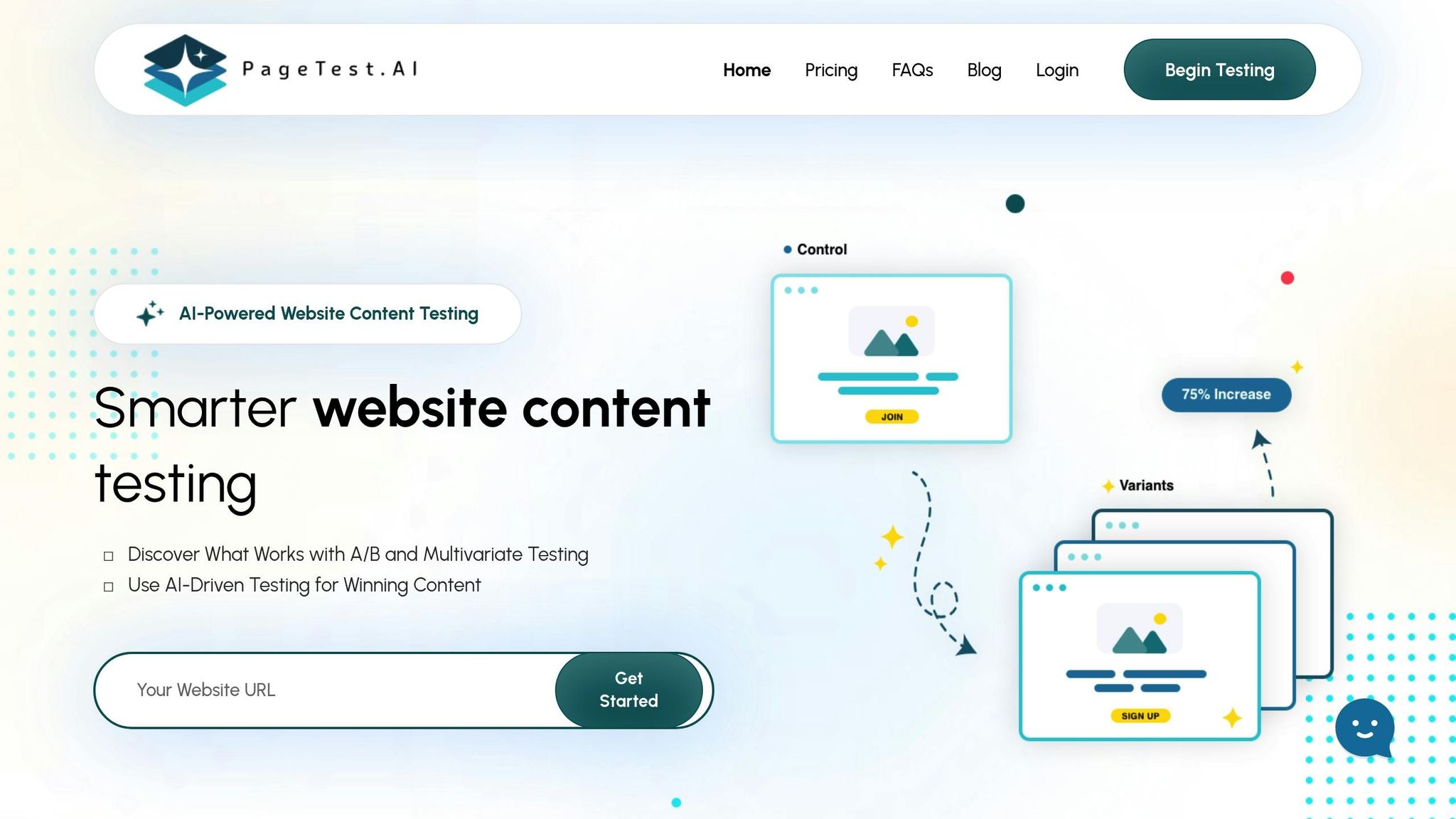

Best Practices for AI Meta Tag Translation

Best Practices for AI Meta Tag Translation
 15-11-2025 (Last modified: 15-11-2025)
15-11-2025 (Last modified: 15-11-2025)
AI meta tag translation can transform your multilingual SEO strategy by making it faster, more efficient, and scalable. Poorly translated meta tags hurt user engagement and search rankings, but AI tools offer a solution by automating translations while maintaining context and intent. This ensures your site appeals to global audiences without sacrificing quality.
Key Takeaways:
- Why It Matters: 72.1% of users prefer native-language websites, and businesses using proper localization see up to a 47% increase in traffic and 55% higher conversions.
- How AI Works: AI uses machine learning to translate and optimize meta tags (like titles and descriptions) for local audiences, handling large volumes of content quickly.
- Steps to Success:
- Research keywords for each target language – don’t rely on direct translations.
- Use AI tools for initial translations, ensuring they respect local formats (e.g., currency, dates).
- Review and refine translations with human oversight to ensure natural, engaging results.
- Optimization Tools: Platforms like PageTest.AI help test and improve translated meta tags by analyzing user behavior and click-through rates.
By combining AI with human review and ongoing testing, businesses can maintain SEO consistency, improve user experience, and expand into new markets effectively.
What is AI Meta Tag Translation?
AI meta tag translation uses machine learning to translate and optimize title tags, meta descriptions, alt text, and technical metadata into multiple languages. Unlike manual translation, AI systems can handle large volumes of metadata quickly and consistently. This makes them especially useful for large e-commerce sites or content-heavy platforms, where translating every element manually would be overwhelming. By offering speed and consistency, AI makes it easier to manage multilingual SEO at scale.
These systems rely on advanced natural language processing (NLP) to understand context and intent, which helps avoid clunky or overly literal translations that don’t connect with local audiences. They can also use translation memories and learn from past translations to improve accuracy over time. This means your meta tags aren’t just translated – they’re adapted to local markets and optimized for search engines. The result? Better localization and stronger SEO performance across different languages.
Key elements that benefit from AI-driven translation include title tags (the clickable headlines in search results), meta descriptions (the summaries below the titles), alt text for images, and other technical metadata. Getting these elements right is critical to ensuring that your SEO strategy works effectively across multiple languages.
How AI Improves Multilingual SEO
AI takes multilingual SEO to the next level by making keyword translation smarter. Instead of just translating keywords directly, AI identifies terms that are relevant to local audiences, adapting to regional search habits and preferences. This ensures that your content aligns with how people actually search in different markets.
AI also simplifies technical SEO tasks, like generating and updating hreflang tags and sitemaps for each language version. These features help search engines understand how your multilingual pages are connected. On top of that, AI allows for rapid testing of different meta tag versions, so businesses can fine-tune their strategies to improve search rankings and user engagement in various regions.
Problems with Manual Meta Tag Translation
Manual translation comes with several drawbacks. It’s slow, inconsistent, and prone to errors, which can hurt both SEO and user trust. Poor translations can lead to a fragmented user experience and make your SEO efforts less effective. There’s also the risk of technical mistakes that can negatively impact your site’s visibility.
For sites that frequently update content – like e-commerce platforms adding new products or revising descriptions – keeping all language versions up to date can feel impossible without automation. Hiring professional translators for ongoing updates is costly and often delays market expansion or forces businesses to compromise on quality. AI offers a way to overcome these challenges, making it easier to maintain SEO consistency across multiple languages.
Step-by-Step Guide to AI Meta Tag Translation
Tapping into AI’s capabilities for multilingual SEO can elevate your meta tag translations. Here’s a straightforward three-step process that blends automation with human expertise to make sure your meta tags not only rank well in search results but also connect with local audiences.
Step 1: Research Keywords for Target Languages
When it comes to keyword research, avoid relying on direct translations – they rarely align with how people actually search in different regions. For example, while someone in the U.S. might search for "running shoes", a user in Spain would more likely type "zapatillas deportivas." Local search habits and vocabulary matter.
Use tools like Google Keyword Planner, SEMrush, or Ahrefs to uncover high-performing keywords for your target language. Pay close attention to search volume, competition, and user intent. These tools can help you identify terms that resonate with local audiences rather than sticking to literal translations.
Google Trends is another great resource for spotting seasonal trends and emerging search terms. It provides insights not just into what people are searching for, but also when. Once you’ve nailed down your localized keyword list, you’re ready to move on to automated translations.
Step 2: Use AI Tools for Initial Translation
AI tools can handle the heavy lifting of translating your meta tags, but they need to be used strategically. After identifying your target keywords, feed them into AI-powered translation tools specifically designed for metadata. These tools are particularly useful for managing character limits – about 60 for title tags and 155 for meta descriptions.
Choose AI tools that support real-time translation and can process large volumes of content quickly. Make sure they handle technical details like special characters, punctuation, and formatting differences across languages. For U.S.-specific formatting, configure the tools to display numbers, dates, and measurements correctly (e.g., $1,000.00, MM/DD/YYYY, imperial units).
Additionally, look for AI systems that can generate and update essential SEO elements like hreflang tags, canonical URLs, and language-specific sitemaps to streamline your workflow.
Step 3: Review and Refine Translations
Even with advanced AI, human review is non-negotiable. Automated translations often miss the nuances of idiomatic expressions or emotional undertones, which is why a native speaker should review every meta tag. This ensures the translations are clear, engaging, and aligned with local preferences.
Focus on keeping the tone consistent with your brand and making sure the meta tags sound natural. Test the translations in live search results to confirm they display correctly within character limits. Since some languages take up more space than others to express the same idea, you may need to tweak the phrasing.
To improve future translations, integrate these manual edits into your translation management system. Building a library of "translation memories" ensures consistent, high-quality output for upcoming projects. This hybrid method combines the efficiency of AI with the cultural sensitivity and precision that only human expertise can deliver.
Best Practices for AI Meta Tag Translation and Optimization
To get the most out of AI-assisted meta tag translation, it’s all about striking the right balance between automation and quality control. These practices ensure your translated meta tags not only perform well in search engines but also resonate with local audiences. Building on earlier translation steps, these tips help create localized, effective meta tags.
Keep Content and Meta Tags Consistent
Your meta tags need to match your page content – this is non-negotiable for effective SEO. As outlined earlier, mismatched language between meta tags and on-page content can confuse search engines and harm your rankings. When your meta tags don’t align with the content, search engines receive mixed signals about what your page is actually about.
For U.S.-focused content, make sure to use American English, correct currency formatting (e.g., $1,234.56), and references that align with local preferences. For instance, if your page discusses "fall fashion trends" using American terminology, your meta tags should mirror that language rather than using terms common elsewhere.
This consistency ensures users know exactly what they’re clicking on when they see your page in search results.
Avoid Over-Optimization and Keyword Stuffing
Stuffing your meta tags with keywords might seem like a shortcut, but it’s a risky move. Overloading meta tags with keywords can lead to search engine penalties and turn off users, ultimately hurting your SEO efforts. As mentioned earlier, human review is crucial to prevent these pitfalls. Instead of cramming in every possible keyword, focus on naturally weaving your primary keyword into concise, user-friendly copy.
For example, instead of writing something like, "Best running shoes, top running shoes, cheap running shoes for runners", try something more engaging: "Explore premium running shoes built for comfort and performance. Free shipping on U.S. orders over $75." This approach not only avoids penalties but also makes your listing more appealing, boosting click-through rates.
Use AI for Large-Scale Meta Tag Generation
When it comes to scaling up, AI is a game-changer. AI excels at generating meta tags for massive content libraries quickly and effectively. For websites with thousands of pages, AI can create unique, relevant meta tags at scale. This helps you avoid generic, duplicate tags that can negatively impact your SEO.
Here’s an example: An e-commerce site using a combination of AI and human oversight for 15 languages saw a 27% boost in organic traffic. Similarly, a travel booking platform that implemented AI-driven meta tag translation for 20 languages experienced a 15% increase in click-through rates.
To make the most of AI, feed it specific page data like product names and features. Instead of relying on one-size-fits-all templates, configure your AI to include details like pricing and localized information. This way, each meta tag feels tailored and relevant.
For U.S. audiences, it’s essential to ensure your AI tools are set up to handle local formatting standards – dollar signs, imperial measurements (inches, feet, pounds), Fahrenheit temperatures, and MM/DD/YYYY date formats. These seemingly small details contribute to a seamless user experience, which builds trust and encourages engagement with your content.
sbb-itb-6e49fcd
Using PageTest.AI for Meta Tag Testing and Optimization

Once you’ve translated your meta tags using AI tools, the next step is to ensure they resonate with real users. PageTest.AI makes testing and refining your translated meta tags simple and accessible, even if you don’t have technical expertise. Designed to streamline the process, this platform empowers marketers to make data-driven decisions that enhance multilingual SEO performance.
Meta tags play a crucial role in SEO, and PageTest.AI takes this a step further by enabling smarter, data-backed testing. Instead of relying on guesswork, the platform allows you to test multiple translated meta tag variations simultaneously, using real user behavior to guide your choices. This is especially important for multilingual websites, where local preferences and search habits can vary widely. With PageTest.AI, the process of testing and optimizing becomes efficient and effective.
PageTest.AI Features for Meta Tag Optimization
PageTest.AI offers a range of tools to refine your meta tags. One standout feature is its AI-generated content variations, which create multiple versions of meta titles and descriptions for testing. This is particularly useful for multilingual content, as the platform can account for differences in character length (like between English and German) or adapt to specific punctuation rules in languages such as Japanese or Arabic.
Another handy tool is the no-code Chrome extension. By highlighting the meta tags you want to test, the system takes care of the technical setup for you. This eliminates the need for developer support, giving marketing teams the freedom to test and tweak content independently.
The platform also includes performance tracking tools that provide detailed metrics, such as click-through rates, engagement levels, bounce rates, and user behavior. For multilingual campaigns, these insights are broken down by language and region, offering a clear picture of what works best in each market. Additionally, PageTest.AI integrates seamlessly with popular website platforms like WordPress, Wix, and Shopify, ensuring compatibility regardless of your setup.
How to Test and Improve Meta Tags with PageTest.AI
Optimizing your meta tags with PageTest.AI is straightforward and follows a simple three-step process:
- Select the meta tag content to test: Using the Chrome extension, highlight the meta title or description you want to optimize. The platform then identifies it as a test element.
- Generate and refine variations: PageTest.AI’s AI creates optimized versions of your selected meta tag content instantly. You can use these suggestions as-is or tweak them further to align with your brand and local market preferences. This ensures your meta tags are tailored to the specific needs of each audience.
- Track performance and implement winning versions: The platform analyzes metrics like clicks, engagement, and time on page to determine which meta tag variations perform best. For multilingual sites, you can run multivariate tests to compare elements like local keywords versus generic translations or culturally adapted descriptions versus literal ones. The results help you pinpoint the most effective combinations for each market.
This structured approach can lead to measurable SEO gains. Businesses that consistently test and refine their meta tags have reported up to 15% more organic traffic compared to those that don’t invest in systematic testing.
PageTest.AI also offers flexible pricing to suit different needs. You can start with a free trial, which includes 10,000 test impressions, or opt for enterprise plans that support up to 100,000 impressions per month. This scalability makes it easy to begin small and expand as you see results.
Conclusion: Main Points for AI Meta Tag Translation
AI has revolutionized the way meta tags are translated, making multilingual SEO more efficient and accessible. This technology allows businesses to localize content on a large scale, helping them expand seamlessly into new markets.
While AI excels at handling bulk translations, human oversight remains essential to preserve cultural subtleties. This combination ensures translations are not only fast but also resonate with local audiences, avoiding meta tags that fail to connect due to overlooked cultural contexts. Incorporating local keyword research further aligns meta tags with specific regional search behaviors.
A solid technical foundation is equally important. Features like hreflang tags and canonical URLs guide search engines to deliver the correct content to the right audience. Without these elements in place, even the most accurate translations might not reach their intended users.
Beyond the basics, consistent testing and fine-tuning are key to long-term SEO success. AI-powered translations provide a great starting point, but regular A/B testing is crucial for identifying which meta tag variations truly engage users. This iterative process ensures your strategy stays aligned with user preferences.
Tracking metrics like click-through rates, bounce rates, and user engagement offers valuable insights to keep your meta tags performing at their best. With a methodical approach to testing and optimization, businesses can see tangible improvements in organic traffic and user interaction across their target markets.
AI-driven meta tag translation combines automation, cultural awareness, and ongoing refinement, giving businesses the tools they need to achieve multilingual SEO success.
FAQs
How does AI help ensure translated meta tags preserve the original meaning and intent?
AI uses advanced natural language processing (NLP) models to ensure translated meta tags stay true to the original context and intent. These models dig into the subtleties of the source language – like tone, phrasing, and nuances – and adapt them seamlessly to the target language.
On top of that, AI evaluates translated meta tags for SEO purposes. It ensures that keywords are not just translated but also localized, making them relevant to the target audience. This approach boosts search engine rankings and enhances user engagement across different regions.
What challenges can arise when using AI for translating meta tags, and how can these be addressed?
Using AI to translate meta tags can be a double-edged sword. While it offers speed and efficiency, it often misses the subtleties of cultural context, misrepresents your brand’s tone, or produces translations that come across as overly generic. These missteps can hurt your SEO performance and fail to connect with your audience effectively.
The solution? Pair AI translations with human expertise. Having a professional review ensures that the translations not only stay true to your brand’s voice but also resonate with your audience and convey the right message. This balanced approach combines the speed of AI with the precision and cultural awareness that only a human touch can provide.
How does AI-powered meta tag translation improve SEO performance for different languages and regions?
AI-powered meta tag translation plays a key role in boosting SEO by accurately localizing metadata like titles and descriptions for specific languages and regions. This ensures the content aligns with the preferences and search habits of local audiences, which can lead to better search engine rankings.
On top of that, AI tools refine meta tags by optimizing for keywords and readability, helping to improve click-through rates (CTR) and overall user engagement. Automating this process allows businesses to expand their SEO efforts across multiple markets efficiently, all while maintaining top-notch localization quality.
Related Blog Posts
say hello to easy Content Testing
try PageTest.AI tool for free
Start making the most of your websites traffic and optimize your content and CTAs.
Related Posts

 13-11-2025
13-11-2025
 Ian Naylor
Ian Naylor
AI Tools for Testing Visual Hierarchy
Explore how AI tools can enhance your website’s visual hierarchy, improving user experience and boosting conversion rates significantly.

 11-11-2025
11-11-2025
 Ian Naylor
Ian Naylor
How to Analyze Mobile Abandonment Patterns
Understand mobile abandonment patterns to enhance user experience and recover lost revenue by addressing key friction points during checkout and onboarding.

 10-11-2025
10-11-2025
 Ian Naylor
Ian Naylor
How Multivariate Testing Fails Without Proper Planning
Effective multivariate testing requires clear goals, focused variables, and adequate data. Poor planning can lead to wasted resources and unreliable results.
